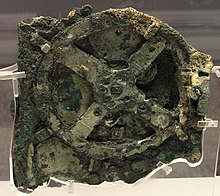[ST Ref: PT-B1-C7_220813: ‘Planetoid Trilogy’, ‘Star Island’, Chapter Seven: “Chance Meeting”.]

Barrie Cameron makes reference to the Antikythera Mechanism in his science fiction novel, ‘Star Island‘. The reference relates to a gift, a watch, whose design is influenced by the Antikythera Mechanism.
Origins of the Antikythera Mechanism
The Mechanism was believed to have been built in the second century BC by Greek craftsmen. Experts who have studied the complex mechanism believe that its designers would have possessed knowledge of inner solar system astronomy. Also, many believe that the design of the mechanism evolved from several earlier prototypes.
There is some evidence suggesting that the design of the Mechanism may have been influenced by astronomer Hipparchus of Rhodes who lived in the 2nd century BC.
Wikipedia has an excellent entry describing the Mechanism.
Simulations of the Mechanism
Freeth and Jones discovered when investigating their simulation of the Mechanism that it was not particularly accurate. They point out that this was not due to an inaccuracy in the gearing ratios of the mechanism but rather to inadequacies in the Greek theory of planetary movements upon which the design was based. Apparently the accuracy could not have been improved until Ptolemy (c. 100 – c. 170 AD) and Kepler made their contributions to astronomy some centuries later, (in particular, see:. Kepler’s laws of planetary motion, published between 1609 and 1619 AD).

Later Influences
The Greeks are believed to have influenced the astronomers of later cultures. The Roman philosopher Cicero published a document (54-51 BC), a philosophical dialogue, that mentioned two machines that were by Archimedes and which were probably types of planetarium. It is further thought that the Greek technology may have been transmitted to the Byzantine and Islamic states. There are examples of mechanical devices built during the Middle Ages. While these were relatively complex, they were nonetheless simpler than the Antikythera Mechanism.